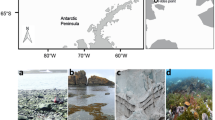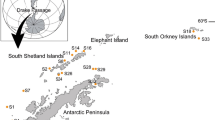Abstract
The Maltese top-shell, Gibbula nivosa Adams 1851, is a critically endangered marine trochid gastropod endemic to the Maltese Islands (central Mediterranean). Previously unrecorded live since 1981, rediscovery of this species in 2006 has enabled the collection of basic biological data for the first time, based on a population in Sliema Creek. The field distribution and habitat preferences of G. nivosa were investigated via stratified random sampling, while aspects of its behaviour were studied through laboratory experiments. Gibbula nivosa occurred primarily in near-homogeneous or homogeneous infralittoral cobble/pebble beds, at an overall density of 17.6 ± 25.0 SD individuals m−2; however, large spatial and temporal variations in abundance were recorded. The snails did not exhibit gregarious behaviour and the slightly clumped dispersion pattern noted in the field appeared to result from patchiness of the habitat. Recruitment was observed in post-summer months, which, together with data on shell-size distributions, suggests that G. nivosa spawns in early summer and attains adult size (maximum shell width ~9 mm) in less than 1 year. Gibbula nivosa showed a circadian activity pattern with nocturnal foraging involving indiscriminate ingestion of particles browsed off the substratum; observations on responses to four potential predators suggest that nocturnal activity may have evolved in response to diurnal predation. Historical records of snail occurrence and the present study suggest that population declines of G. nivosa in the past were probably related to habitat alteration as a result of anthropogenic pressure.



Similar content being viewed by others
References
Adams A (1851) Contributions towards a monograph of the Trochidae, a family of gastropodous Mollusca. Proc Zool Soc Lond 14:150–192
Ankel WE (1938) Erwerb und aufnahme der nahrung bei den gastropoden. Verh dtsch zool Ges Zool Anz Suppl 11:223–295
Borg JA, Micallef SA, Pirotta K, Schembri PJ (1997) Baseline marine surveys in the Maltese Islands (Central Mediterranean). In: Özhan E (ed) MEDCOAST 97, Proceedings of the third international conference, Qawra, Malta, November 11–14, 1997
Borg JA, Attril MJ, Rowden AA, Schembri PJ, Jones MB (2002) A quantitative technique for sampling motile macroinvertebrates in beds of the seagrass Posidonia oceanica (L.) Delile. Sci Mar 66:53–58
Boudouresque CF (2004) Marine biodiversity in the Mediterranean: status of species, populations and communities. Sci Rep Port Cros Natl Park 20:97–146
Cachia C (1981) Notes on some uncommon species of molluscs from the Maltese Islands. Boll Malacol 17:291–294
Cachia C, Mifsud C, Sammut PM (1991) The marine shelled Mollusca of the Maltese Islands (Part One: Archaeogastropoda). Grima Printing and Publishing Industries, Msida
Caro T (1998) The significance of behavioural ecology to conservation biology. In: Caro T (ed) Behavioural ecology and conservation biology. Oxford University Press, New York, pp 3–26
Caruana Gatto A, Despott G (1919) Materiali per una malacofauna marina delle Isole Maltesi. Arch Melit 3:431–446
Chatfield C (2004) The analysis of time series: an introduction, 6th edn. CRC Press LLC, Florida
Chelazzi G, Focardi S, Deneubourg J (1988) Analysis of movement patterns and orientation mechanisms in intertidal chitons and gastropods. In: Chelazzi G, Vannini M (eds) Behavioural adaptation to intertidal life. Plenum Publishing Corporation, New York, pp 173–184
Clare AS (1990) Laboratory-induced spawning of the gastropod Gibbula cineraria as an indicator of field spawning. Mar Ecol Prog Ser 63:303–304
Clark PJ, Evans FC (1954) Distance to nearest neighbor as a measure of spatial relationships in populations. Ecology 35:445–453
Crowe TP, Underwood AJ (1998) Testing behavioural “preference” for suitable microhabitat. J Exp Mar Biol Ecol 225:1–11
Despott G (1919) The Mollusca of Marsascirocco Harbour, Malta. Proc Zool Soc Lond 13:168–183
Ebling FJ, Hawkins AD, Kitching JA, Muntz L, Pratt VM (1966) The ecology of Lough Ine. XVI. Predation and diurnal migration in the Paracentrotus community. J Anim Ecol 35:559–566
Evans J, Borg JA, Schembri PJ (2010) Rediscovery of live Gibbula nivosa (Gastropoda: Trochidae). Rapp Comm Int Mer Medit 39:507
Fretter V, Graham A (1994) British prosobranch molluscs: their functional anatomy and ecology, 2nd edn. The Ray Society, London
Ghisotti F (1976) Considerazioni su Gibbula nivosa A. Adams, 1851. Conchiglie 12:79–88
Ghisotti F, Melone G (1972) Catalogo illustrato delle conchiglie marine del Mediterraneo. Conchiglie Suppl 4:79–144
Giannuzzi-Savelli R, Pusateri F, Palmeri A, Ebreo C (1997) Atlante delle conchiglie marine del Mediterraneo, volume 1: Archaeogastropoda. La Conchiglia, Rome
Green RH (1966) Measurement of non-randomness in spatial distributions. Res Pop Eco 8:1–7
IUCN (2001) IUCN Red List categories and criteria: version 3.1. IUCN species survival commission. Gland, Switzerland
Kendall MA, Williamson P, Garwood PR (1987) Annual variation in recruitment and population structure of Monodonta lineata and Gibbula umbilicalis populations at Aberaeron, Mid-Wales. Est Coast Shelf Sci 24:499–511
Kobelt W (1888) Prodromus faunae molluscorum testaceorum maria europaea inhabitantium. Von Bauer e Raspe, Nürnberg
Little C (1989) Factors governing patterns of foraging activity in littoral marine herbivorous molluscs. J Mollus Stud 55:273–284
Mallia A, Briguglio M, Ellul AE, Formosa S (2002) Physical background, demography, tourism, mineral resources and land-use. In: Axiak V, Gauci V, Mallia A, Mallia E, Schembri PJ, Vella AJ, Vella L (eds) State of the environment report for Malta, 2002. Ministry for Home Affairs and the Environment, Malta, pp 39–161
Marko PB, Palmer AR (1991) Responses of a rocky shore gastropod to the effluents of predatory and non-predatory crabs: avoidance and attraction. Biol Bull 181:363–370
Meisel DV, Byrne RA, Kuba M, Griebel U, Mather JA (2003) Circadian rhythms in Octopus vulgaris. In: Warnke K, Keupp H, Boletzky Sv (eds) Coleoid cephalopods through time. Berl Palaobiolgische Abh 3:171–177
Olabarria C, Underwood AJ, Chapman MG (2002) Appropriate experimental design to evaluate preferences for microhabitat: an example of preferences by species of microgastropods. Oecologia 132:159–166
Palazzi S (1978) Osservazioni sull’habitat di Gibbula nivosa A. Adams, 1851. Conchiglie 14:177–180
Robertson DR, Sheldon JM (1979) Competitive interactions and the availability of sleeping sites for a diurnal coral reef fish. J Exp Mar Biol Ecol 40:285–298
Rueda JL, Marina P, Salas C, Urra J (2008) Jujubinus striatus (Linnaeus, 1758) (Gastropoda: Trochidae) from a deep Zostera marina bed in southern Spain (Alboran sea): aspects of ecology and biology. J Mollus Stud 74:345–354
Schembri PJ (1985) The Maltese top-shell. Civilization 19:518–519
Schembri PJ, Borg JA, Deidun A, Knittweis L, Mellado Lopez T (2007) Is the endemic Maltese topshell Gibbula nivosa extinct? Rapp Comm Int Mer Médit 38:592
Schmitt RJ (1996) Exploitation competition in mobile grazers: trade-offs in use of a limited resource. Ecology 77:408–425
Scotti G, Chemello R (2000) I molluschi marini mediterranei degni di protezione: stato di conoscenza e forme di tutela. Boll Malacol 36:61–70
Siebeck UE, Marshall NJ (2000) Transmission of ocular media in labrid fishes. Philos Trans R Soc B 355:1257–1261
Sutherland WJ (1998) The importance of behavioural studies in conservation biology. Anim Behav 56:801–809
Takada Y, Russo GF, Mazzella L (1999) Activity patterns and habitat preferences of two herbivorous gastropods (Gibbula umbilicaris and Jujubinus exasperatus) on leaves of the Mediterranean seagrass Posidonia oceanica. Benthos Res 54:71–80
Thake MA, Schembri PJ (1989) Mollusca. In: Schembri PJ, Sultana J (eds) Red data book for the Maltese Islands. Department of Information, Valletta, pp 79–89
Underwood AJ (1972) Spawning, larval development and settlement behaviour of Gibbula cineraria (Gastropoda: Prosobranchia) with a reappraisal of torsion in gastropods. Mar Biol 17:341–349
Williams EE (1964) The growth and distribution of Gibbula umbilicalis (Da Costa) on a rocky shore in Wales. J Anim Ecol 33:433–442
Zar JH (1996) Biostatistical analysis, 3rd edn. Prentice-Hall Inc., New Jersey
Acknowledgments
The present work was partly funded through a Malta Government Scholarship Scheme grant (ME 367/07/35) awarded to JE. The study conforms fully to the laws of Malta, and we thank the Malta Environment and Planning Authority for granting the necessary permits which enabled us to study the protected Maltese top-shell. We are grateful to two anonymous referees for their comments on a previous version of this paper.
Author information
Authors and Affiliations
Corresponding author
Additional information
Communicated by U. Sommer.
Rights and permissions
About this article
Cite this article
Evans, J., Borg, J.A. & Schembri, P.J. Distribution, habitat preferences and behaviour of the critically endangered Maltese top-shell Gibbula nivosa (Gastropoda: Trochidae). Mar Biol 158, 603–611 (2011). https://doi.org/10.1007/s00227-010-1584-4
Received:
Accepted:
Published:
Issue Date:
DOI: https://doi.org/10.1007/s00227-010-1584-4




